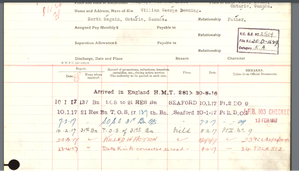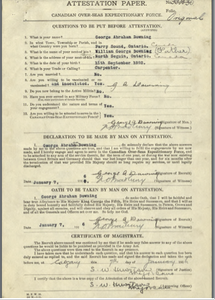DOWNING, GEORGE ABRAHAM, PTE Reg # 808370
George Abraham Downing was born September 15, 1892 to William George Downing and Sarah Elizabeth Sugden.
At the time of the 1891 census the Downing family lived in Spence Township where they remained at the time of the 1911 census. At the time of the 1911 census, 18 year old George described himself as a farmer.
At the time of enlistment, George identified his trade as that of a carpenter. He identified his next of kin as his father William George Downing living in North Seguin.
He signed his attestation papers on January 7, 1916 in Calgary
George embarked for England on August 21, 1916 on the S.S. OLYMPIC arriving in Liverpool on the 30th.
He was transferred to the 31st Battalion.
In February, 1917 George arrived in his Unit in France.
On April 7he left for his Unit, the 2nd Ent. Battalion (although he was still listed as being in the 31st). He was reported as killed in action between April 8 and April 12, 1917.

 The CEF Commonwealth Grave Register
The CEF Commonwealth Grave Register
It was in April of 1917 that the Battle of Vimy Ridge took place. The Canada War Museum provides the following description:
“The victory at Vimy was a defining event for Canada, considered by many contemporaries and later scholars to be a significant event in Canada’s progress to full independence from Britain.
The seven-kilometre long Vimy Ridge in northern France, near Arras, held a commanding view over the surrounding countryside. Previous unsuccessful French and British attacks had suffered over 150,000 casualties.
In early 1917, British High Command ordered the Canadian Corps to capture the position as part of a larger spring offensive in the Arras area. In the coming campaign, British forces to the south would have limited success, and the French would fail badly, with many of their units reduced to mutiny. The Canadian attack against Vimy Ridge would be spectacular by comparison.
Lieutenant-General Sir Julian Byng, the Canadian Corps commander, ordered new tactics for the coming assault. Having learned from the Battle of the Somme, intense training better prepared soldiers for what they might find on the battlefield, and helped them to make quick decisions on their own that were still in keeping with the overall plan. Small units and individual soldiers were given much more information about the battle, and were expected to exercise initiative in keeping the advance moving, even if their officers were killed or wounded.
A tremendous artillery barrage, which included improved techniques for counter-battery fire against enemy guns, would smash German positions and isolate enemy troops in their dugouts.
At 5:30 a.m. on 9 April 1917, Easter Monday, nearly 1,000 guns opened fire on the German positions. An estimated 15,000 Canadians rose from the trenches and advanced towards the ridge in the first wave, with thousands more behind them. Despite hard fighting all across the front, the Canadians captured most of the ridge on the 9th, and the remaining portions of it by the 12th.”








